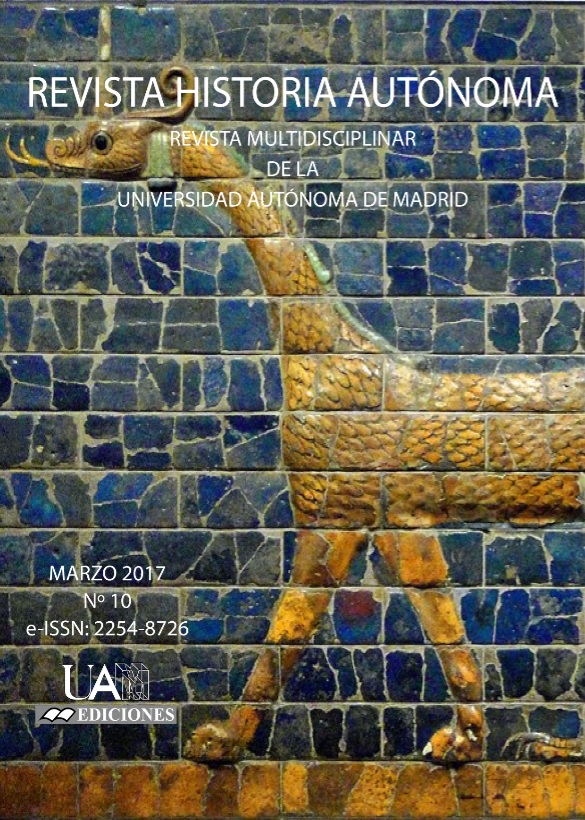Mythical Anatomies: the case of Agustín Luengo Capilla, ‘The Giant of Extremadura’
Abstract
The aim of this paper is to revise the life history and especially the post mortem history of a “giant” who had and still has the greatest media coverage of the Spanish giants of all times: Agustín Luengo Capilla (1849-1875), known as “The Giant from Extremadura”. The famous Spanish surgeon Pedro González Velasco met him in Madrid, and the result derived from that relationship was really peculiar: Luengo’s remains became part of the Anthropological Museum founded by Velasco in 1875, currently National Museum of Anthropology. We analyze the legend created around Luengo (and Velasco) and we question the direction and part of the contents of a project that aims “to promote” the knowledge of his life. Our criticism is based on the fact that the project validates the legend and the inventions of a recently published novel about the giant, and on the fact that both narratives just offer a spurious image of him.Downloads
References
Arquiola, Elvira “González Velasco, reformador de los saberes morfológicos”, en Medicina & Historia. Revista de Estudios Históricos de las Ciencias Médicas, 14 (1986), pp. 3-26.
Blanchard, Pascal et al. (dirs.), Exhibitions. L’invention du sauvage, París, Actes Sud, Musée du quai Branly, 2011.
Blanckaert, Claude, La Vénus hottentote. Entre Barnum et Muséum, París, Muséum national d’Histoire naturelle, 2013.
Durán Rodríguez-Hervada, Alejandra et al. “Acromegalia”, en Medicine, 9-13 (2004), pp. 766-773.
Folgado de Torres, Luis C., El hombre que compraba gigantes. La historia más alucinante duerme en un museo, Madrid, Áltera, 2013.
Giménez Roldán, Santiago, El Doctor Velasco. Leyenda y realidad en el Madrid decimonónico, Madrid, Editorial Creación, 2012.
Gylseth, Christopher Hals y Lars Toverund, Julia Pastrana: The Tragic Story of the Victorian Ape Woman, Gloucestershire, The History Press, 2004.
González Velasco, Pedro, “Exposición Universal de París de 1878. Objetos remitidos por el Dr. Velasco”, en El Anfiteatro Anatómico Español y el Pabellón Médico, 122 (1878), p. 32.
Herder, Wouter W. de, “The History of Acromegaly”, en Neuroendocrinology, 103 (2016), pp. 7-17.
Martin-Márquez, Susan, “A «scientific confidence»: Manuel Iradier, «El Negro de Banyoles», and the re-collection and re-membering of «Spanish Africans»”, en Journal of Romance Studies, vol. 1, 3 (2001), pp. 103-120.
Martínez Aranda, María Adoración et al., “Las controversias de los «materiales culturales delicados», un debate aplazado pero necesario”, en Ph investigación, 2 (2014), pp. 1-30.
Porras Gallo, María Isabel, “Buscando la renovación de la enseñanza médica en la España decimonónica: La Escuela Teórico-Práctica de Medicina y Cirugía del Hospital General de Madrid y la Escuela Práctica de Medicina y Cirugía de Pedro González de Velasco”, en Medicina & Historia, 1 (2002), pp. 1-15.
Puig-Samper Mulero, Miguel Ángel, “El Doctor Pedro González de Velasco y la antropología española del siglo XIX”, en Asclepio. Revista de Historia de la Medicina y de la Ciencia, 34 (1982), pp. 327-337.
Pulido, Ángel, El Dr. Velasco, Madrid, Establecimiento Tipográfico de E. Teodoro, 1894.
Sánchez Gómez, Luis Ángel, “El Museo Antropológico del doctor Velasco (anatomía de una obsesión)”, en Anales del Museo Nacional de Antropología, 16 (2014), pp. 265-297.
Sánchez Gómez, Luis Ángel “¿Human Zoos or Ethnic Shows? Essence and contingency in Living Ethnological Exhibitons”, en Culture & History Digital Journal, vol. 2, 2 (2013).
Sánchez Gómez, Luis Ángel, “Una momia en el salón. Los museos anatómicos domésticos del doctor Velasco (1854-1874)”, en Asclepio. Revista de Historia de la Medicina y de la Ciencia, vol 67, 2 (2015).
Sheaves, Richard, “A History of Acromegaly”, en Pituitary, 2 (1999), pp. 7-28.
